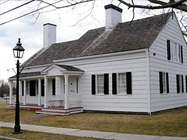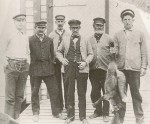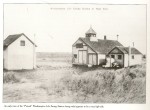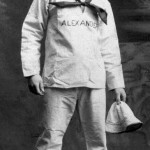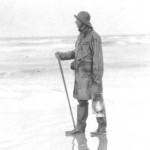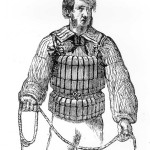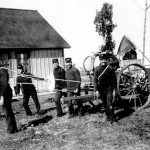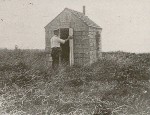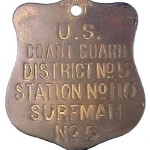- Home
- About
- Support
- History
- Town of Southampton Tour of Historic Places
- Our History
- The Foster-Meeker Heritage Center
- Area History
- The Baldt Anchor History
- Tuttle-Fordham Mill History
- Local Schools History
- Net Reel – Beach Lane Bridge – History
- Potunk Life Saving Station History
- The Castle & Theophilus Brouwer History
- The History of The Westhampton Beach Post Office
- Westhampton Beach Fire Department History
- Events
- Newsletters
- Visit
- Resources
- Contact Us

Shipwrecks were all too common along the coast of Long Island during the 1800s and continued to occur up until around 1940. The loss of life, as well as cargo, was overwhelming and the public outcry to do something about this reached Washington DC. Decisions were finally made. In 1871 the Secretary of the Treasury was authorized by Congress to employ crews of experienced surfmen at lifeboat stations at a maximum rate of $40 per month, marking the end of the volunteer system. This was the beginning of direct Federal control over life-saving activities. The United States Life Saving Service was officially established on June 18, 1878 by a Congressional vote.
By 1914, there were 30 life saving stations along the shores of Long Island from Montauk Point to New York City. Stations were spaced every 3 to 5 miles. The Westhampton Station was called Petunk, West Hampton, and Potunk at various times over the years. The station was #75 and later was changed to #17. It was sited approximately “1 1/2 miles SW of Potunk Village”.
There were a number of different style buildings that were typically in use in the Life Saving Service. The Potunk Station was a red building designed like a salt-box style house.
The men that staffed the stations were a tough lot, usually fishermen from local families. They followed a vigorous training schedule. Daily, both the Keeper and the surfmen practiced life saving skills such as launching the life boats as quickly as possible, and shooting the Lyle gun with its life line, in order to be fully prepared in time of need. They were on constant watch for ships in distress from the Station’s tower and kept records of passing vessels as well. At night the surfmen walked patrols along the beach – one man heading each way from their station and meeting the surfman from the next station midway. They exchanged “checks” and returned to their own station. If needed, they would light Coston signal flares to warn off ships straying too close to the shore, and in case of floundering ships, headed back to their station to return with the crew and a fully-equipped beach cart. They were prepared at all times to go out on the water, no matter the weather conditions, to save lives.
The Surfman’s Motto – ” You have to go out – but you don’t have to come back”
The following were some of the men stationed at the Potunk Life Saving Station – KEEPERS Ebenezer Jayne – 1856, Franklin C. Jessup – 1872, 1881-1896, Edward H Ryder- 1873, Isaac Davidson Gildersleeve – 1903, 1911, SURFMEN: William Bishop, John Culver , Walter H Edwards, Richard O Goodman, Mortimer D. Howell, Nathan C Jessup, Franklin W Phillips, Charles L Raynor, Sidney H Raynor William C Raynor, David Rogers, Halsey Rogers
For more information on the US Life Saving Service, please visit US Life Saving Service Heritage Association.
Potunk (Westhampton)(No. 75)(1855-1937)
Assigned Rescue Craft
1856: Francis metallic pulling surfboat
1882 to 1930s: Beebe, Beebe-McLellan, and Race Point-type pulling surfboats
1933: Type S pulling surfboat No. 4520
The Potunk Station was active in 1935 but had become inactive by the time of the 1938 Hurricane, when it was totally destroyed. For WWII beach patrol purposes, a new lookout tower was built on the site.
Information and map courtesy of Tim Dring – US Life Saving Service Heritage Association)
The following is a list of known shipwrecks in the Westhampton area – there were many, many more along the coast of Long Island. The Life Saving Service saved hundreds of lives during those years.
December 5 1800 – Traveller January 6, 1806 – Veroni November 9, 1806 – Lucretia Decembr ?, 1808 – Betsy January 2, 1876 – Bill Baxter January 2, 1876 – Marcus Hunt
October 5, 1877 – Armstrong January 28, 1878 – Frederick February 28, 1881 – Walter B. Chester February 21, 1885 – Jordon L. Mott March 6, 1887 – City of Chicago April 4, 1889 – Asa J. Moore
February 2, 1902 – Belle of Oregon – 4 men died February 2, 1902 – Antelope 1910 – General Reid January 4, 1931 – Wm. R. Page
In April 2013 additional information was located at the National Archives. Weekly Journals were filed by the Keeper of each station. The journal of April 9, 1890 filed by Keeper Franklin C Jessup describes another wreck that landed on the shores in Westhampton Beach. Read for yourself the report of that day, some 123 years ago.
The journal report reads as follows: At 11:15 PM yesterday the three masted schooner Annie E J Morse came on shore 1 mile WSW of this station. Patrolman H. Culver saw the vessel at 11:30 PM, reported at this station at 11:45 PM. At 12 AM we were underway with the surf boat. At 12:45 we was alongside of the wreck. Took off four men, all that dared to risk the chance of getting ashore in our boat and was back to the station at 2 AM. At 5 AM again went to the wreck and took off the remaining six men and was back to the station at 7 AM. Rescued ten men – all that was aboard. The sea was too large to land their baggage.
At midnight it was very dark and stormy. The sea was so rough that in going through the surf the boat strained and sprung a leak that kept one man continually bailing until we got on shore.
Franklin C Jessup

Several days later – life was back to normal at the station and the surf boat was repaired – ready for the next rescue.
By the way – if you are a descendant of one of these men and have heard stories that were passed down in your family, we would love to hear them! We continue to gather more information about these fearless men who saved so many lives right here on our beaches.
Another incident of note involved the British Steamer City of Chicago. According to the book Wrecks and Rescues on Long Island by Van R. Field, on March 6, 1887 at 3:40 A.M. during thick and rainy weather, with a gale blowing out of the east, the City of Chicago steamer struck about 650 yards offshore and about one third of a mile east of the Petunk Station. The ship was spotted by a surfman on patrol who signaled with a Coston flare. He returned to the station to alert the others and Keeper Jessup called Quogue and Moriches Stations for help.
The surfmen tried several times to get a line aboard with the Lyle gun. After several attempts they finally managed to shoot a light line to the ship. This line was fastened aboard, and the surfmen attached a heavier line to their end – this would be the line used to suspend the Breeches Buoy to rescue the passengers.
While the men on the ship were pulling the heavier line toward them it broke.
The rescue was now deemed too dangerous to attempt and the surfmen signalled the ship with their intention to await better conditions. Fortunately, by noon of that day, the tide rose enough for the steamer to back off the beach under her own power. This ship was 5,202 tons and carried 639 passengers and crew!
The Belle of Oregon was not so fortunate. On February 2, 1902,the crew of four were lost. The Belle of Oregon had been converted to a barge. During a storm that night it broke loose from the tow and sank. The bodies of the crew washed ashore near the Potunk Station. Below is a photo of the Belle of Oregon as she originally looked before her transformation into a barge.
Additional information can be found in numerous books:
The U.S. Life-Saving Service Heros, Rescues and Architecture of the Early Coast Guard: by Ralph Shanks, Wick York and Lisa Woo Shanks, editor
Wrecks and Rescues on Long Island: by Van R. Field
The Hamptons Life-Saving Stations (Historical Landmarks as Shore Change Indicators): by Dr. Stephen P. Leatherman, Director Laboratory for Coastal Research & International Hurricane Center
Good Ground Remembered: by Helen M. Wetterau
Good Ground & Its Nautical History: by Helen M. Wetterau
